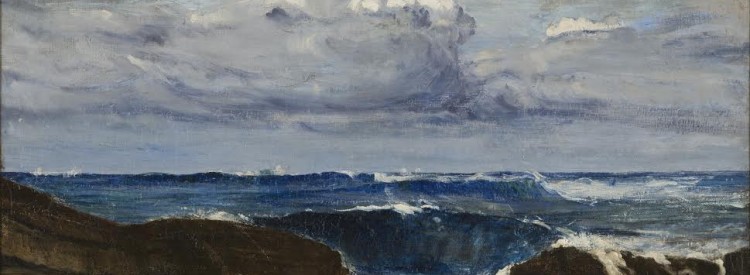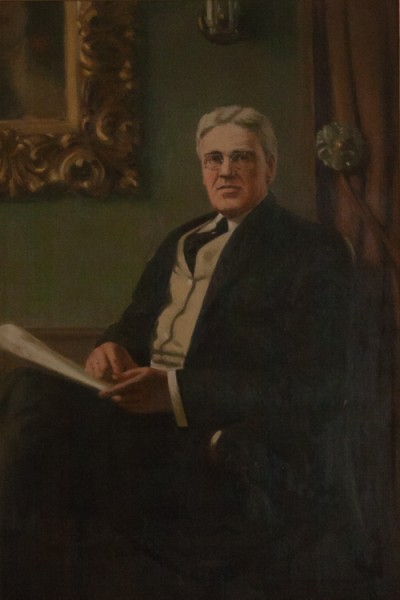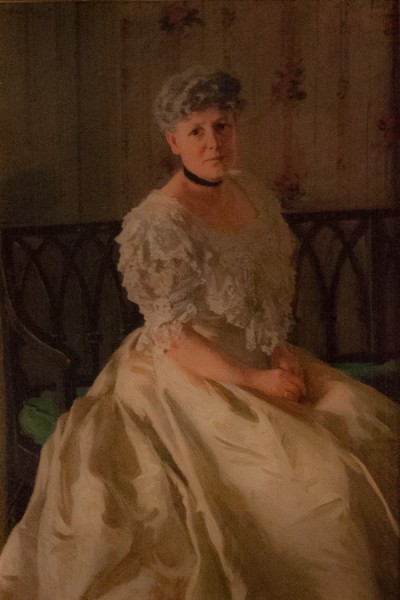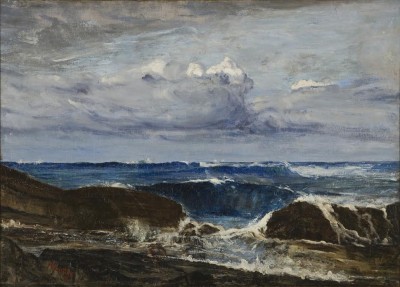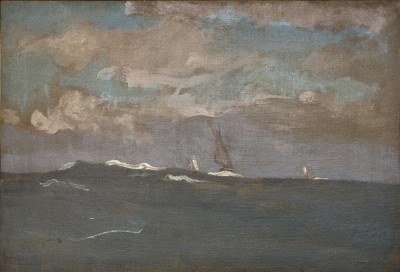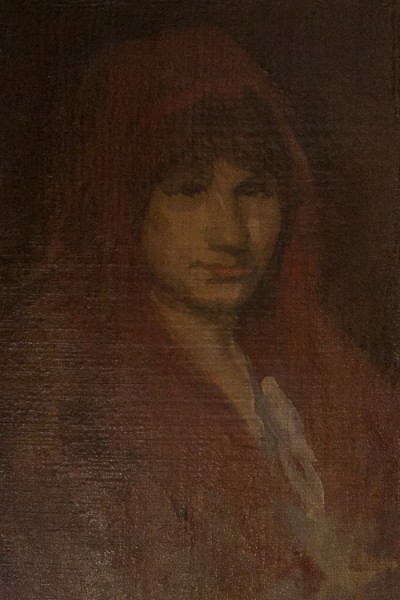Arthur Pope (American, 1880-1974)
Arthur Pope painted this portrait of his uncle posthumously, using two photographs. The photograph from which the composition was taken showed an older-looking Alfred Pope. Arthur Pope chose to substitute a younger appearance onto his uncle. In the portrait one sees a partial view of another work from the collection, Head of a Woman by Eugène Carrière, over Alfred’s right shoulder.
Portrait of Alfred Atmore Pope
Oil on linen, ca. 1920s-1930s
51 x 33½ in. (129.2 x 85 cm)
Inscription: none
Ellen Emmet Rand (American, 1875-1941)
The Connecticut artist Ellen Emmet Rand was from a well-connected family, counting Henry and William James as cousins and Stanford White, Charles McKim (of McKim, Mead & White) and John Singer Sargent as friends. Her art education was extensive: she studied with Kenyon Cox and William Merritt Chase in New York, and was advised by John Singer Sargent, Frederick MacMonnies, and James McNeill Whistler in London and Paris.
Portrait of Ada Brooks Pope
Oil on canvas, 1906
49½ x 33½ in. (125.5 x 85.2 cm)
Inscription upper left: Ellen Emmet 1906
Three years before she completed this portrait of Mrs. Pope, Rand purchased a farm in Salisbury, Connecticut. She became an accomplished portrait artist, painting such notables as President Franklin D. Roosevelt, Augustus Saint-Gaudens, Mrs. Alfred Vanderbilt, and the Popes’ neighbor and friend, Anna Roosevelt Cowles.
This portrait of Mrs. Pope was painted in 1906. Note that Mrs. Pope is seated on a tri-chair back, painted settee that can be seen in the upstairs hall.
Alice Ravenel Huger Smith (American, 1876-1958)
Charleston, South Carolina artist Alice Ravenel Huger Smith was a contemporary of Theodate Pope Riddle, and the two shared similar interests, such as Colonial architecture and historic preservation. Smith’s art was greatly influenced by the composition of Japanese prints. Smith succeeded at architectural rendering, illustration, and wood block printing, but landscape painting was her true calling. The loose application of paint to paper, suggestive of a sketch, is typical of Smith’s style.
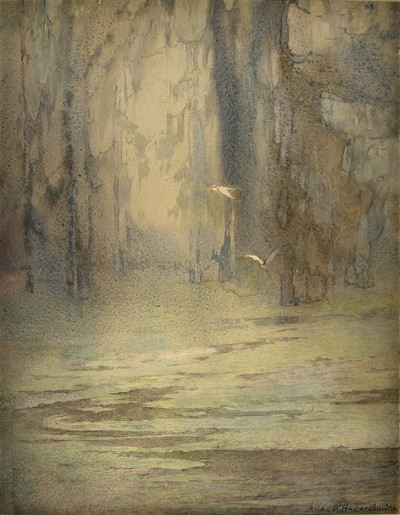 Trees and Cranes
Trees and Cranes
Watercolor, ca. 1920s-1930s
22 x 17 in. (55.5 x 43.1 cm)
Signature lower right: Alice R. Huger Smith
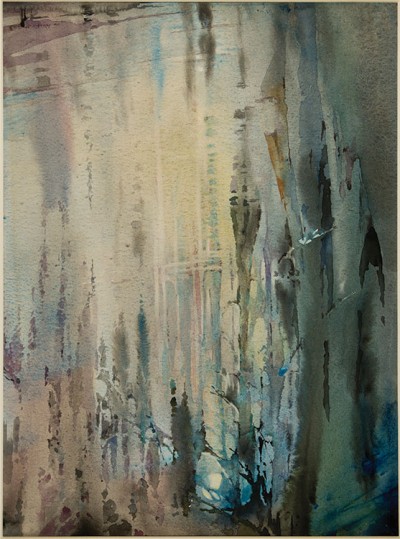 Trees by Moonlight
Trees by Moonlight
Watercolor, ca. 1920s-1930s
17 x 11½ in. (43.8 x 29.1 cm)
Signature lower right: Alice R H Smith
Trees and Cranes depicts two birds in flight at the edge of a body of water. Trees by Moonlight depicts a watery, night-time scene, with trees cast in the light of the pale moon that rises in the background.
Little is known of the circumstances under which Theodate acquired these two watercolors – among the few works of fine art she herself brought into the collection at Hill-Stead – except that she was in Charleston in the mid-1920s, and met Smith, who eventually came to live at Hill-Stead and became Theodate’s protégé.
James McNeill Whistler (American, 1834-1903)
James McNeill Whistler left the United States when he was 21 years old and never returned. However, he did encourage the patronage of American collectors such as Alfred Pope, who purchased seven of his paintings, four of which remain in the collection, and 18 of his prints, 16 of which are permanently on view. The paintings span 30 years of Whistler’s career and reflect his evolution from Realism to a more fluid Impressionistic approach. Hill-Stead’s archives include correspondence between Whistler and Alfred Pope that reveals the depth of their friendship and mutual regard.
The Blue Wave, Biarritz
Oil on canvas, 1862
25¾ x 35 in. (65.3 x 88.8 cm)
Inscription in red at lower left: Whistler 1862
Whistler was 28 years old when he painted The Blue Wave, Biarritz, considered by some to be the artist’s second major seascape (the first being The Coast of Brittany, 1861, now at The Wadsworth Atheneum Museum of Art in Hartford, Connecticut).
The composition of breaking waves on a rocky shore in The Blue Wave indicates the influence of Gustave Courbet; however, Whistler was beginning to create a style that was breaking away from what he decried as “that damned realism.” This emerging style is evident in the rocks as flat patches of brown instead of mottled from light to dark to create three-dimensional forms and details. The way in which he used light, wispy brush strokes to render the clouds in a blue-grey sky was a technique that would become a prominent feature in his later work.
After Mr. Pope purchased The Blue Wave from Goupil & Company in London in 1894, he wrote to his good friend and fellow Impressionist collector, Harris Whittemore, “I was taken with ‘The Blue Wave’ it seemed & seems masterful. Its [sic] about the size of a large Monet, in style its [sic] very like a Courbet… the color is different, blue instead of green, the waves more natural not suggesting tapestry & yet far from the photographic sea of Henry Moore.”
The Blue Wave is framed in a Whistler-designed frame that the artist had commissioned for this piece and sent to Mr. Pope in Cleveland.
Symphony in Violet and Blue
Oil on canvas, 1893
20 x 29 in. (50.5 x 73.5 cm)
Inscription lower left: butterfly monogram
Whistler remarked, “As music is the poetry of sound, so painting is the poetry of sight and subject matter has nothing to do with it. Art should be independent of claptrap – should stand alone and appeal to the artistic sense of eye or ear …” Symphony in Violet and Blue, painted on the Brittany coast when the artist was almost 60, reflects this philosophy with the broad strokes of blues, blue-greens and whites of both the sky and sea creating a whole. Whistler inscribed this work in the lower left with his characteristic butterfly signature.
The Popes met Mr. and Mrs. Whistler while on a trip to England and Europe in 1894, and purchased Symphony in Violet and Blue directly from the artist at that time. The frame for this painting is the same design Whistler applied to another of his paintings in the Pope collection, The Blue Wave, Biarritz.
Carmen Rossi
Oil on canvas, ca. 1895
20 x 12 in. (50.8 x 30.5 cm)
Inscription left side: large butterfly painted in black on her sleeve
Carmen Rossi was a model for Whistler both as a child and again as a young woman in the late 1890s. From 1898 to 1901, she ran an art school, Académie Whistler, for which the artist wrote a “code of conduct” and where he gave informal lessons. He severed his ties for health reasons in 1901, and the Académie Whistler closed shortly thereafter.
A receipt from Whistler’s dealer in New York, E.G. Kennedy of Wunderlich & Co., shows that Mr. Pope returned another Whistler portrait, Little Rose of Lyme Regis (now at the Museum of Fine Arts in Boston, in the American Wing) in 1896 for a credit of $3,500 in exchange for Carmen Rossi at a cost of $2,100. Mr. Pope was friends with Whistler at this time and inquired as to whether the work was signed, for which the artist admonished him for not seeing his butterfly monogram emblazoned on Carmen’s sleeve.
